A Sequential Approach for Integrated Coal and Gas Mining of Closely-Spaced Outburst Coal Seams: Results from a Case Study Including Mine Safety Improvements and Greenhouse Gas Reductions
Abstract
:1. Introduction
2. Regional and Mine Geology
3. Sequential Approach for Integrated COCS Coal and Gas Mining
3.1. Fundamental COCS Mining Principles
- (1)
- Coordinate roadway tunneling, gas extraction, and coal mining. First, gas pre-extraction can be carried out in areas far from coal production. This can effectively reduce the gas content and pressure in order to prevent gas disasters during roadway tunneling and coal mining. Second, pressure relief gas extraction in mining areas can fully develop the gas to ensure safe coal mining. Finally, coal seam gas can be extracted from the goaf.
- (2)
- Determine a reasonable mining sequence for outburst coal seams. It is necessary to mine protective seams in COCS sequences. Generally, the coal seam with the lowest outburst risk is mined first as a protective seam. In the Songzao mining area, the M7 seam is the protective seam and the M8 is the protected seam. Gas pressure in the protected seam will be relieved and the permeability of the protected seam will be enhanced substantially. Thus the gas in the protected seam will be extracted more completely. The high outburst risk in the protected seam will be reduced to a low outburst risk or no outburst risk. These steps will promote safe coal and gas mining.
3.2. System for Gas Extraction in COCS Mines
3.2.1. Pre-Tunneling Gas Extraction
3.2.2. Pre-Mining Gas Extraction
3.2.3. Gas Extraction During Coal Mining
3.2.4. Post-Mining Gas Extraction
- (1)
- The Songzao mining area is located in the mountains in southwestern China and it is difficult and very expensive to drill the long holes from the surface necessary to reach the coal seams.
- (2)
- The Songzao mining area coal seams are thin or of only medium-thickness and their permeabilities are low. Gas extraction efficiency using surface wells is very low.
3.3. Details of the Integrated COCS Mining Approach
3.3.1. Temporal Relationships of COCS Integrated Coal and Gas Mining
- (1)
- The development section
- (a)
- Work for the development section should be begun 5 to 8 years prior to the preparation section. The timing for this section must consider the speed of rock roadway tunneling and the efficiency of gas extraction.
- (b)
- A new gallery level should be deepened when the service life of the current mining level is less than 8 years.
- (c)
- The recoverable period for developed coal reserves should be more than 5 years, the recoverable period for preparation coal reserves should be more than 1.5 years, and the recoverable period for workable reserves should be more than 1 year.
- (d)
- The rock roadway, safety systems, and pipes in the new gallery level must be completed 1 to 1.5 years before the production capacity of the current mining level begins to decrease.
- (e)
- All preparations for mining in the replacement mining area must be completed 6 months before the production capacity of the current mining area begins to decrease.
- (2)
- Gas extraction prior to coal mining
- (a)
- Gas pre-extraction should be largely completed during the preparation section, and gas extraction should begin 3 to 5 years prior to coal mining. Determining the amount of lead time required must consider a number of factors including the coal seam’s gas content and permeability, which techniques, if any, have been used to increase the coal seam’s permeability, and the effectiveness of the extraction.
- (b)
- Gas pre-extraction by cross-measure boreholes in thin and protective seams should initiated at least 12 months prior to coal roadway tunneling.
- (c)
- In most cases, gas pre-extraction by bedding boreholes in protective seams should be done more than 3 months before coal mining begins.
- (3)
- Protective seam advance mining
- (a)
- The roadways for the protective seam working face should be finished 8 months before coal mining so that the requirements for gas extraction before mining of the first mined seam can be met.
- (b)
- The first working face in a continuous mining area should be opened at least 6 months in advance of coal production.
- (c)
- The replacement interval between adjacent working faces shall not be more than 3 months.
- (d)
- The recoverable period for protected coal capacity for the coal mine should not be less than 24 months and the protected coal used for layout of the working face should not be less than 18 months.
3.3.2. Spatial Relationship in COCS Integrated Coal and Gas Mining
- (a)
- A coal roadway must be prepared in advance of the working face in a protective seam to provide space for the next working face. The coal roadway tunneling begins as the working face of protective seam starts to be mined.
- (b)
- Gas roadways must be tunneled in advance of two working faces to provide space for gas pre-extraction by cross-measure boreholes. For example, tunneling for gas roadway #3 will start when working face #2 is being prepared while working face #1 in the protective seam is being mined.
- (c)
- The floor development roadway must be driven in advance of a working face or a gas roadway to provide space for construction of the next gas roadway. As shown in Figure 8, when the #2 gas roadway has been finished, the heading end of the boundary gas roadway would have advanced beyond the #3 gas roadway.
4. Effect of Integrated Coal and Gas Mining in the Songzao Mining Area
4.1. Coal and Gas Production
- (1)
- The Tonghua coal mine, one of the coal mines in the Songzao mining area, closed in 2016. Therefore, gas pre-extraction from this mine ceased in 2014 and the mine produced only coal until mine closure in 2016.
- (2)
- After 2013, the economy in China began a transition and the demand for coal fell for a number of reasons. Consequently, coal production and sales fall sharply because they were affected by the country’s economic downturn.
4.2. Gas Utilization
4.3. Mine Safety
4.4. Unresolved Problems
- (1)
- Bedding boreholes in soft coal seams are difficult to drill and tend to collapse easily. The effectiveness of gas extraction in these holes is poor and the extraction times are long. This leads to only partial gas extraction and gas disasters commonly occurred in these areas during coal mining and roadway tunneling. As a result, cross-measure boreholes must be used as a pre-extraction method to extract the CBM. This makes the gas extraction program more time consuming and expensive.
- (2)
- Because the low permeability of coal seams in the Songzao mining area limits gas extraction, the number of boreholes per unit area must be high; a very large number of holes must be drilled. The result is long construction periods and high costs [29]. To increase the extraction efficiency of the holes, hydraulic fracturing and water jet slotting must be used to enhance seam permeability and achieve satisfactory CBM extraction.
- (3)
- Poor sealing of gas extraction boreholes leads to dilution of the CBM extracted resulting in a low volume percent of methane in the gas delivered for utilization. Gas extracted from the Songzao area mines, for example, contains less than 30% volume percent methane and this accounts for approximately 75% of the total amount of gas extracted. If the CBM extracted is to be used more efficiently, the volume of methane in the extracted gas must be increased.
5. Conclusions
- (1)
- In order to solve the problems that gas extraction difficulties lead to a conflict between mine safety and profit, a sequential approach for integrated coal and gas mining of closely-spaced outburst coal seams has been designed. The fundamental principles for integrated coal and gas mining in COCS is formulates and a system for comprehensive gas extraction in underground coal mines is established. The COCS mining approach can be used in other coal deposits being mined under similar geologic conditions. The COCS mining approach fully coordinates the spatiotemporal relationships between gas extraction, roadway development, and coal mining to ensure mine safety and maximize coal and gas mining efficiency. The mining approach specifies the sequences for coal mining and gas extraction operations in outburst coal seams and stipulates that the coal seam with the weakest outburst risk be used as the protective seam. Gas extraction in COCS is divided into four stages: extraction before coal roadway tunneling, extraction before coal mining begins, extraction during coal mining, and gas extraction from the goaf after coal mining. Gas extraction using cross-measure boreholes, bedding boreholes, a high-level suction roadway, and buried pipes are used for these different stages.
- (2)
- The spatiotemporal relationships between gas extraction, roadway development, and coal mining during the different stages needed to develop a coal mine panel are discussed in three sections in the COCS mining approach. The development section proposes that the floor roadways should be tunneled in advance to provide time and space for pre-mining gas extraction. In the preparation section, the mining approach explains that pre-mining gas extraction should be completed to ensure that both coal roadway tunneling and coal mining can be done safely. In the mining section, the mining approach proposed that protective seam mining should be done months prior to protected seam mining so that protective seam mining can enhance the permeability of the protected seam and thus improve gas extraction efficiency.
- (3)
- The Songzao mining area is taken as a typical case to demonstrate the effectiveness of this mining approach. The mining approach brought three major benefits:Improved mine safety. Between 2010 and 2016, coal production reached a maximum at 5.81 million tons in 2013 but gas exceeding gas monitoring instrument detection limit accidents decreased by 76.3%, physical gas accidents decreased by 66.8%, and the deaths due to gas accidents decreased by 45.1%.Improved coal-bed methane extraction. The amount of gas extracted reached a maximum at 275 million cubic meters. The average tons of gas extraction and the average gas extraction rate were respectively 45.13 m3/t and 62.4%, the highest in China.Application of the COCS sequential mining approach also reduced greenhouse gas emissions. The utilization ratio in the mine used for this case study reached 76.83% and this reduces greenhouse emissions equivalent to 3.5 million tons of carbon dioxide.
Supplementary Materials
Supplementary File 1Author Contributions
Funding
Acknowledgments
Conflicts of Interest
References
- Jiang, B.; Sun, Z.Q.; Liu, M.Q.; Jin, H.G.; Zhang, X.L. China’s energy development strategy under the low-carbon economy. Energy 2010, 35, 4257–4264. [Google Scholar] [CrossRef]
- Beamish, B.B.; Crosdale, J.P. Instantaneous outbursts in underground coal mines: an overview and association with coal type. Int. J. Coal Geol. 1998, 35, 27–55. [Google Scholar] [CrossRef]
- Fisne, A.; Esen, O. Coal and gas outburst hazard in Zonguldak Coal Basin of Turkey, and association with geological parameters. Nat. Hazards 2014, 74, 1363–1390. [Google Scholar] [CrossRef]
- Wang, L.; Cheng, Y.P.; Liu, H.Y. An analysis of fatal gas accidents in Chinese coal mines. Saf. Sci. 2014, 62, 107–113. [Google Scholar] [CrossRef]
- Cheng, Y.P.; Wang, L.; Zhao, X.L. Environmental impact of coal mine methane emissions and responding strategies in China. Int. J. Greenh. Gas. Control 2011, 5, 157–166. [Google Scholar] [CrossRef]
- Flores, R.M. Coalbed methane: From hazard to resource. Int. J. Coal Geol. 1998, 35, 3–26. [Google Scholar] [CrossRef]
- Karacan, C.Ö.; Felicia, A.R.; Michael, C. Coal mine methane: A review of capture and utilization practices with benefits to mining safety and to greenhouse gas reduction. Int. J. Coal Geol. 2011, 86, 121–156. [Google Scholar] [CrossRef]
- Psaltis, S.; Farrell, T.; Burrage, K.; Burrage, P.; Mccabe, P.; Moroney, T. Mathematical modelling of gas production and compositional shift of a csg (coal seam gas) field: local model development. Energy 2015, 88, 621–635. [Google Scholar] [CrossRef] [Green Version]
- Liu, H.; Sang, S.; Formolo, M.; Li, M.; Liu, S.; Xu, H. Production characteristics and drainage optimization of coalbed methane wells a case study from low permeability anthracite hosted reservoirs in southern Qinshui Basin China. Energy Sust. Dev. 2013, 17, 412–423. [Google Scholar] [CrossRef]
- Kong, S.L.; Cheng, Y.P.; Ren, T.; Liu, H.Y. A sequential approach to control gas for the extraction of multi-gassy coal seams from traditional gas well drainage to mining-induced stress relief. Appl. Energy 2014, 131, 67–78. [Google Scholar] [CrossRef]
- Zhou, H.X.; Yang, Q.L.; Cheng, Y.P.; Ge, C.G.; Chen, J.X. Methane drainage and utilization in coal mines with strong coal and gas outburst dangers: A case study in Luling mine, China. J. Nat. Gas Sci. Eng. 2014, 20, 357–365. [Google Scholar] [CrossRef]
- Yuan, L.; Lin, B.Q.; Yang, W. Research progress and development direction of gas control with mine hydraulic technology in China coal mine. Coal Sci. Technol. 2015, 43, 45–49. [Google Scholar]
- Zhou, F.B.; Xia, T.Q.; Wang, X.X.; Zhang, Y.F.; Sun, Y.N.; Liu, J.S. Recent developments in coal mine methane extraction and utilization in China: A review. J. Nat. Gas Sci. Eng. 2016, 31, 437–458. [Google Scholar] [CrossRef]
- Sun, Q.; Zhang, J.X.; Zhang, Q.; Yin, W.; Germain, D. A protective seam with nearly whole rock mining technology for controlling coal and gas outburst hazards: A case study. Nat. Hazards 2016, 84, 1793–1806. [Google Scholar] [CrossRef]
- Liu, Y.K.; Zhou, F.B.; Liu, L.; Liu, C.; Hu, S.Y. An experimental and numerical investigation on the deformation of overlying coal seams above double-seam extraction for controlling coalmine methane emissions. Int. J. Coal Geol. 2011, 87, 139–149. [Google Scholar]
- State Administration of Work Safety. Coal Mine Safety Regulations; China Coal Industry Publishing House: Beijing, China, 2016; pp. 56–119. ISBN 978-7-5020-3589-1.
- Cheng, L.; Ge, Z.L.; Xia, B.W.; Li, Q.; Tang, J.R.; Cheng, Y.G.; Zuo, S.J. Research on Hydraulic Technology for Seam Permeability Enhancement in Underground Coal Mines in China. Energies 2018, 11, 427. [Google Scholar] [CrossRef]
- State Administration of Work Safety. Provisions of the Prevention of Coal and Gas Outburst; China Coal Industry Publishing House: Beijing, China, 2017; pp. 83–136. ISBN 978-7-5020-5227-0.
- Liu, Y.; Xia, B.; Liu, X. A novel method of orienting hydraulic fractures in coal mines and its mechanism of intensified conduction. J. Nat. Gas Sci. Eng. 2015, 27, 190–199. [Google Scholar] [CrossRef]
- Zhang, J.C.; Bian, X.B. Numerical simulation of hydraulic fracturing coalbed methane reservoir with independent fracture grid. Fuel 2015, 143, 543–546. [Google Scholar] [CrossRef]
- Lu, Y.Y.; Yang, F.; Ge, Z.L.; Wang, Q.; Wang, S.Q. Influence of viscoelastic surfactant fracturing fluid on permeability of coal seams. Fuel 2017, 194, 1–6. [Google Scholar] [CrossRef]
- Lu, Y.Y.; Liu, Y.; Li, X.H.; Xia, B.W. A new method of drilling long boreholes in low permeability coal by improving its permeability. Int. J. Coal Geol. 2010, 84, 94–102. [Google Scholar] [CrossRef]
- Sun, D.F.; Chen, J.F.; Long, J.M.; Li, W.S.; Mei, X.D. Experimental study on high pressure hydraulic fracturing technology to uncover coal in cross-cut. Coal Sci. Technol. 2013, 41, 163–165. [Google Scholar]
- Dong, G.F.; Zhai, J.; Zou, L.S.; Yin, X.L. Application of Hydraulic fracturing technology on increasing coal tunneling. J. North China Inst. Sci. Technol. 2013, 10, 22–28. [Google Scholar]
- Ge, Z.L.; Mei, X.D.; Jia, Y.J.; Lu, Y.Y.; Xia, B.W. Influence radius of slotted borehole drainage by high pressure water jet. J. Min. Saf. Eng. 2014, 31, 657–664. [Google Scholar]
- Hu, G.Z.; Wang, H.T.; Li, X.H.; Fan, X.G.; Yuan, Z.G. Numerical simulation of protection range in exploiting the upper protective layer with a bow pseudo incline technique. Min. Sci. Technol. 2009, 19, 58–64. [Google Scholar] [CrossRef]
- Xiao, J.F.; Fan, S.X.; Lu, P.; Chen, Y.Y.; Chen, F. Layout parameter optimization of highly-located drainage roadway along seam for controlling gas with pressure relief from close-distance methane-rich seam group. J. Min. Saf. Eng. 2016, 33, 564–570. [Google Scholar]
- Wang, H.F.; Cheng, Y.P.; Wang, W.; Xu, R. Research on comprehensive CBM extraction technology and its applications in China’s coal mines. J. Nat. Gas Sci. Eng. 2014, 20, 200–207. [Google Scholar] [CrossRef]
- Wu, Y.; Liu, J.S.; Elsworth, D.; Miao, X.X.; Mao, X.B. Development of anisotropic permeability during coalbed methane production. J. Nat. Gas Sci. Eng. 2010, 2, 197–210. [Google Scholar] [CrossRef]
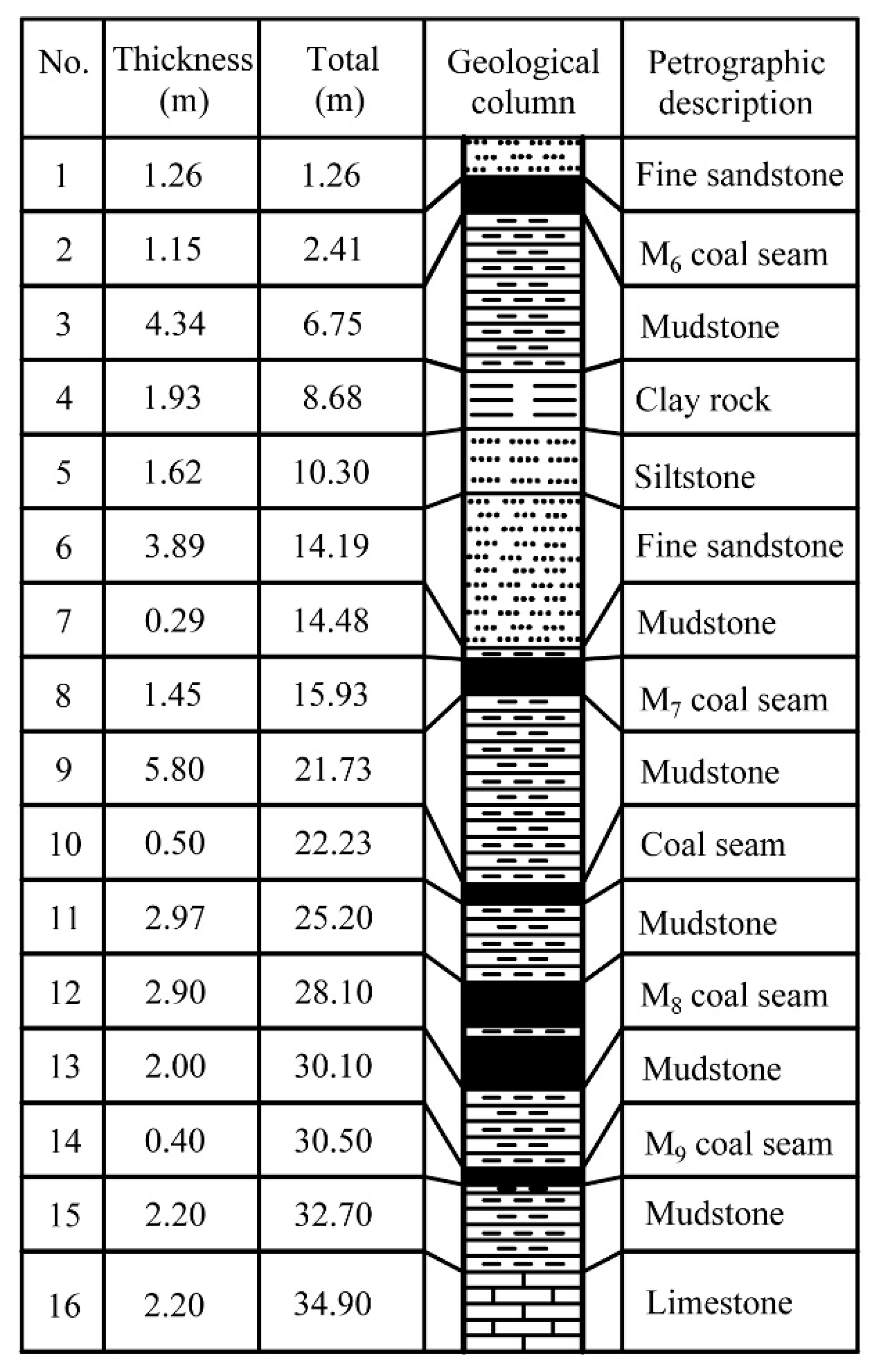
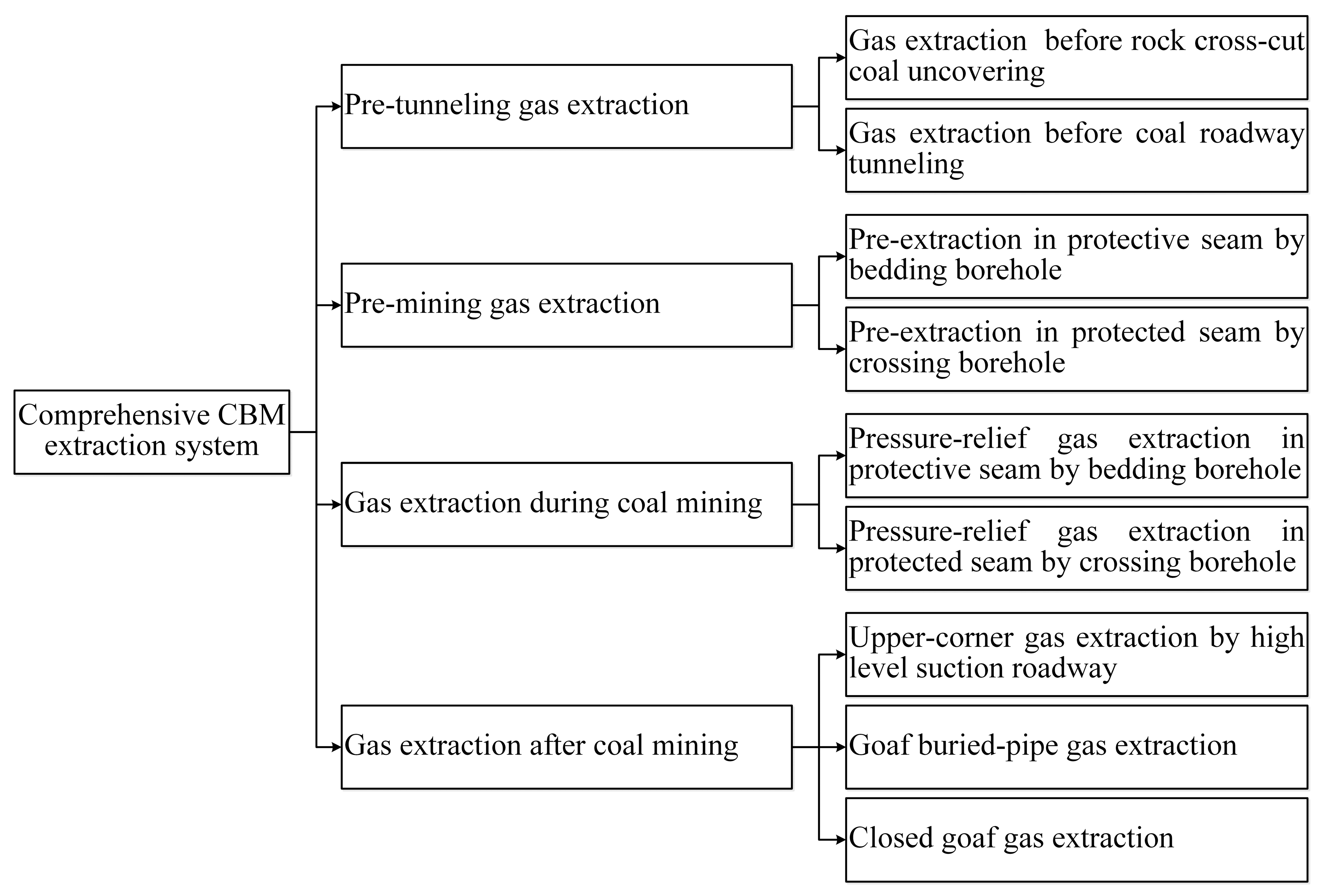

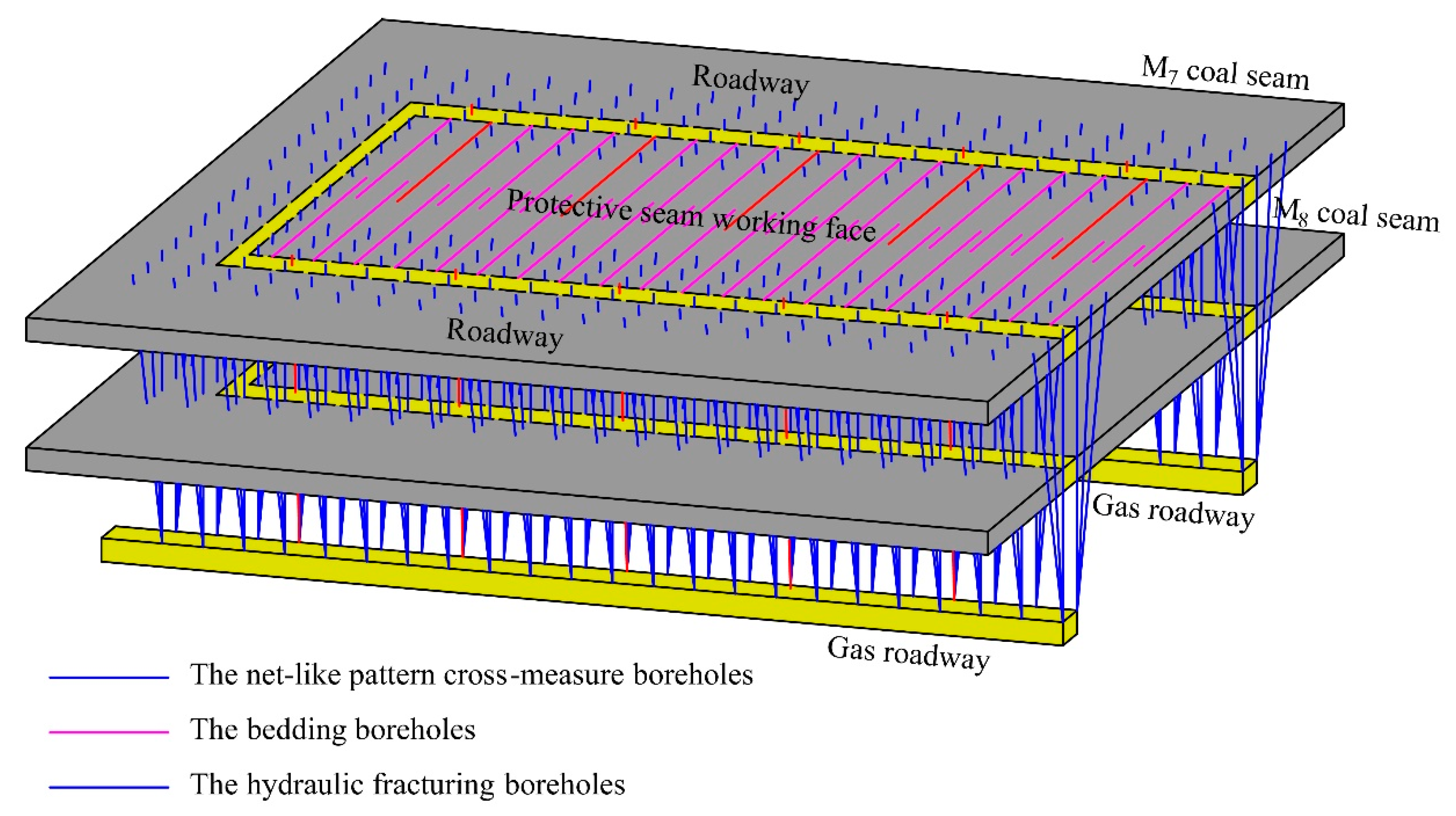
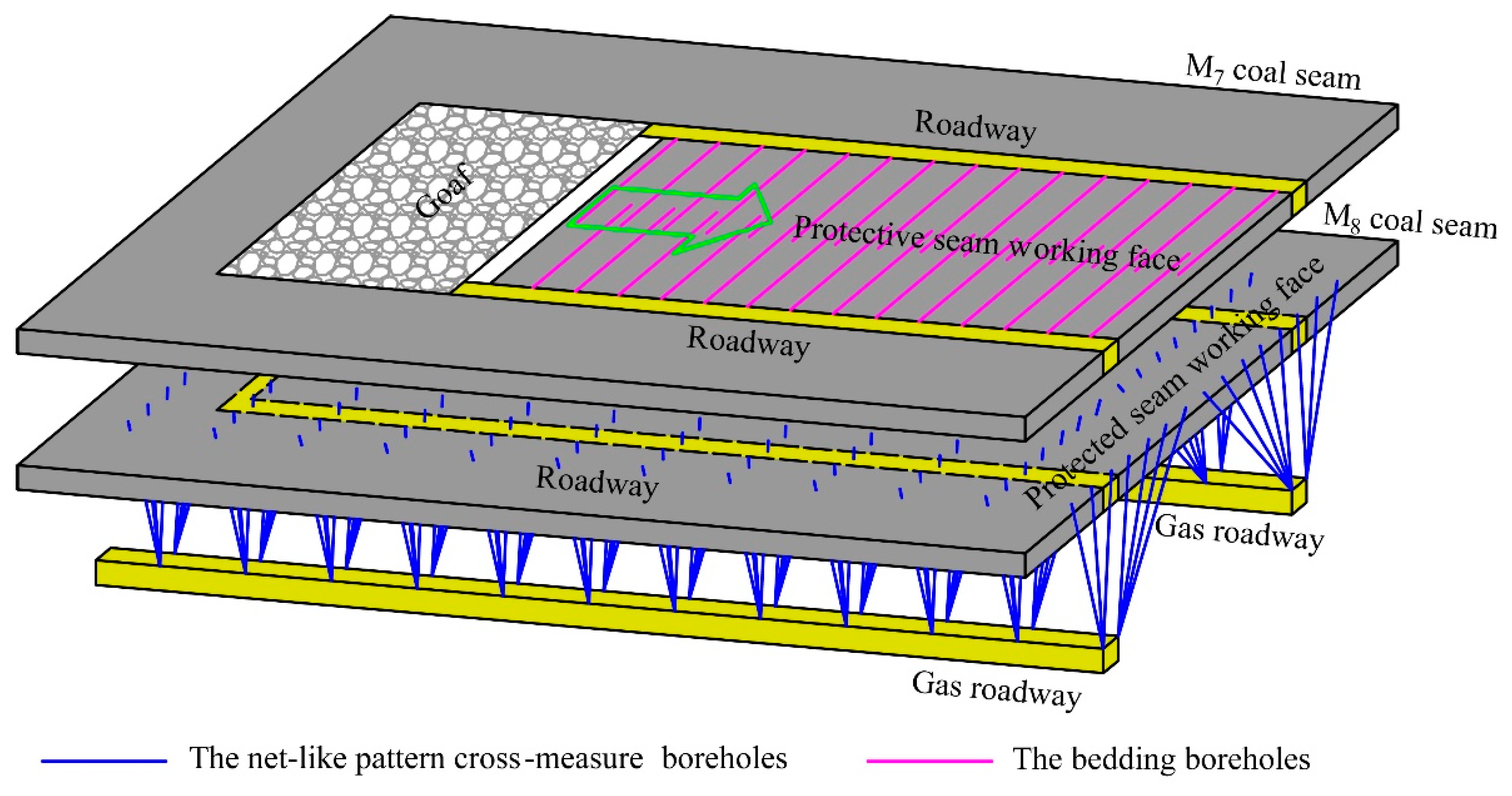
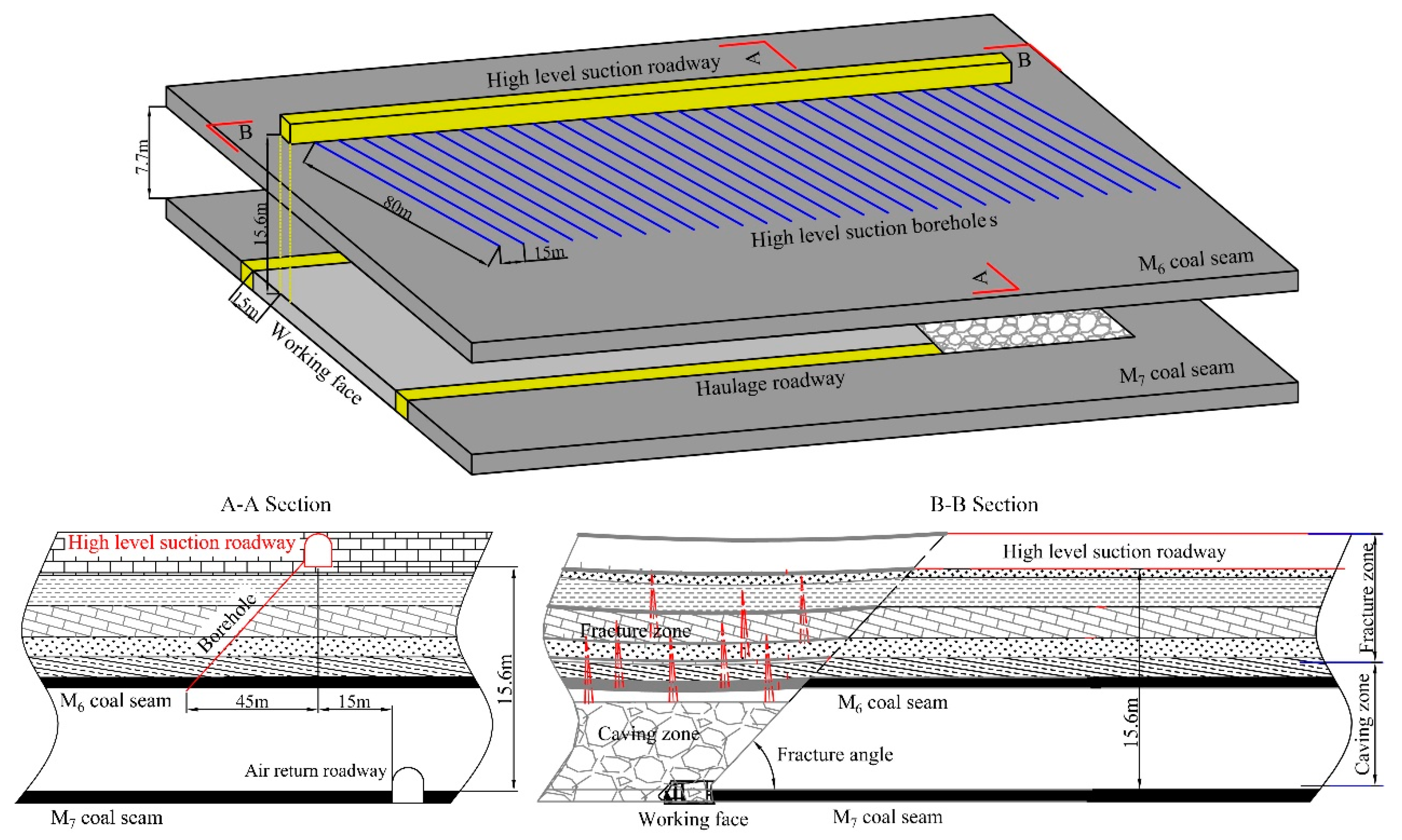
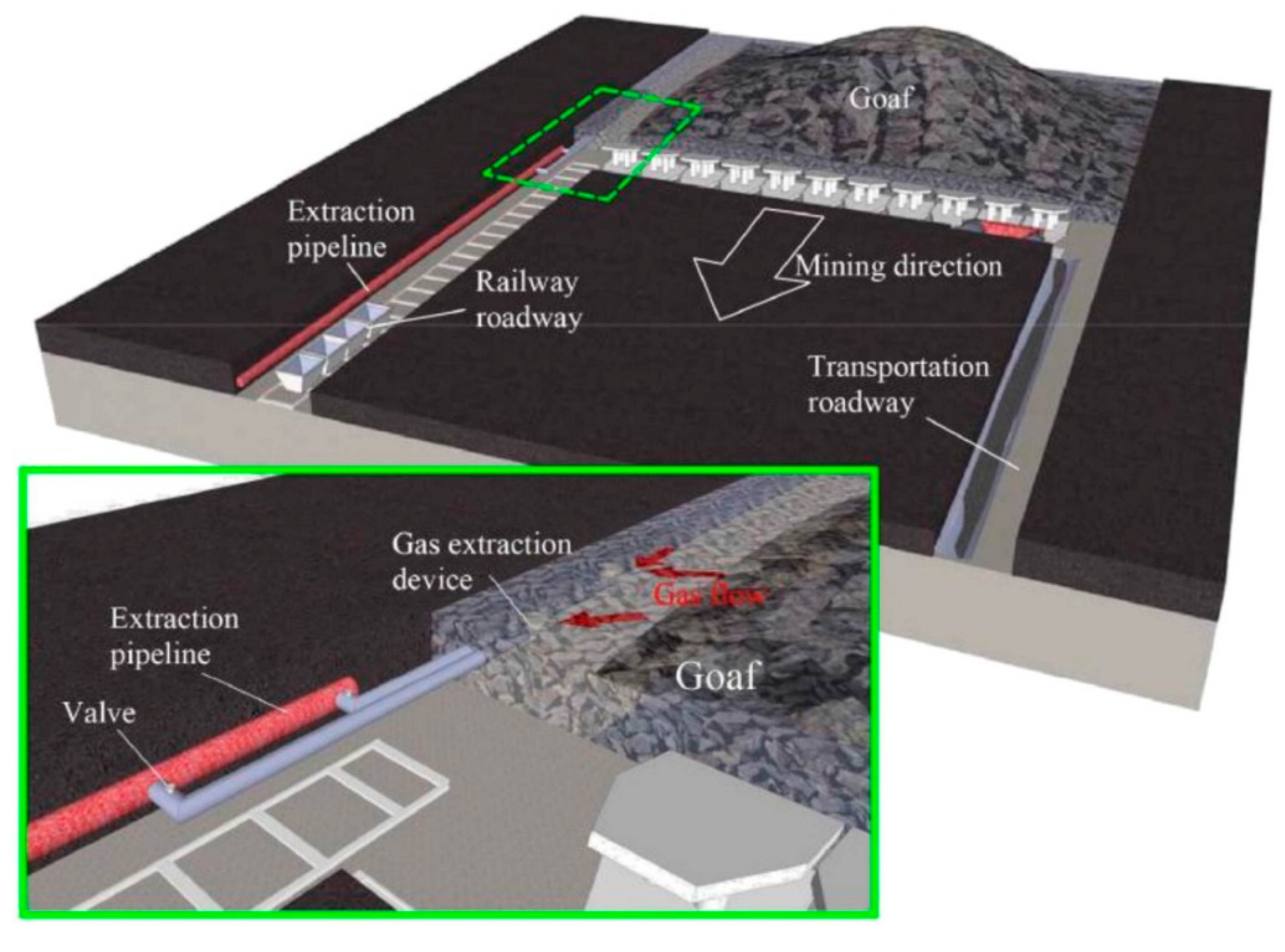

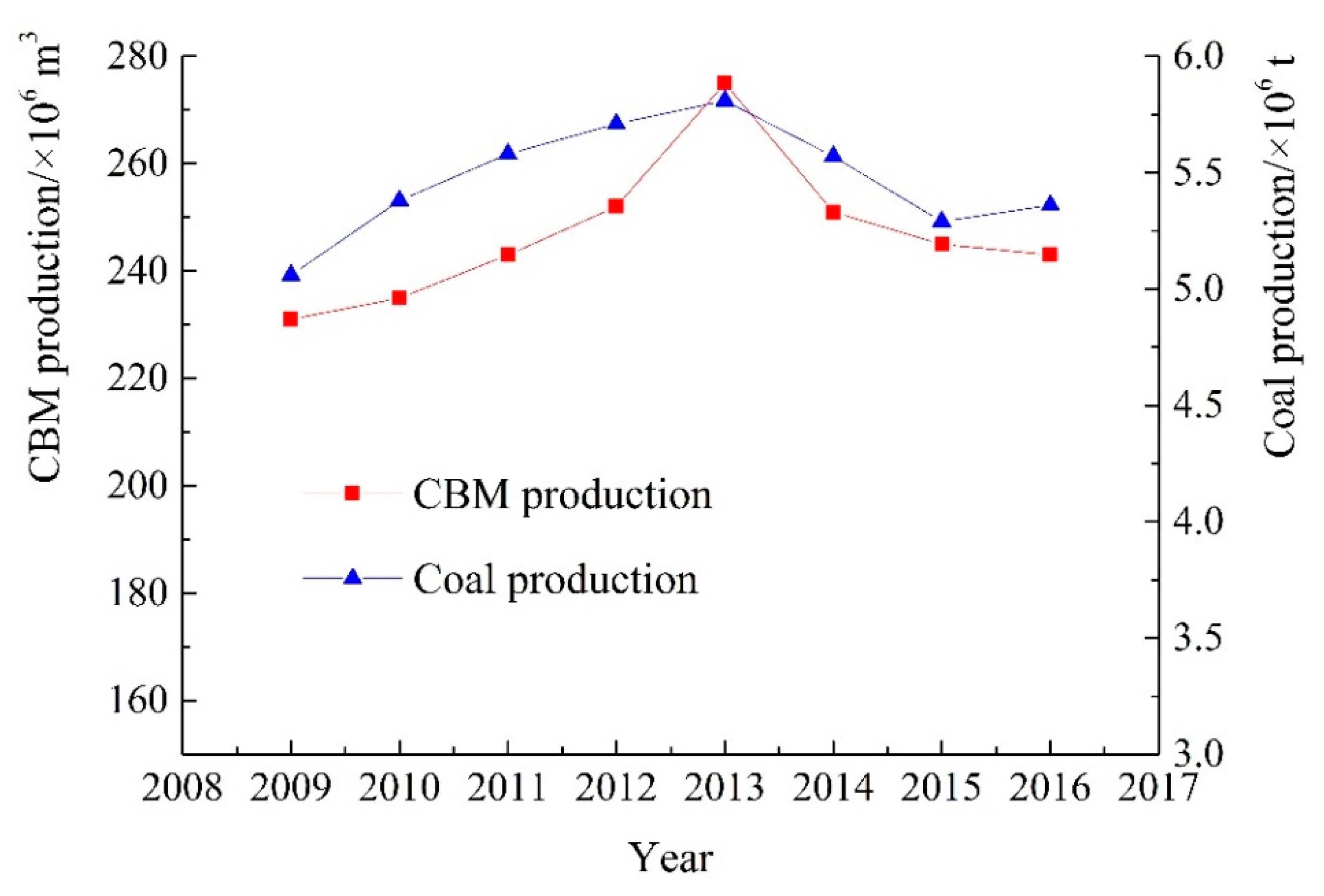

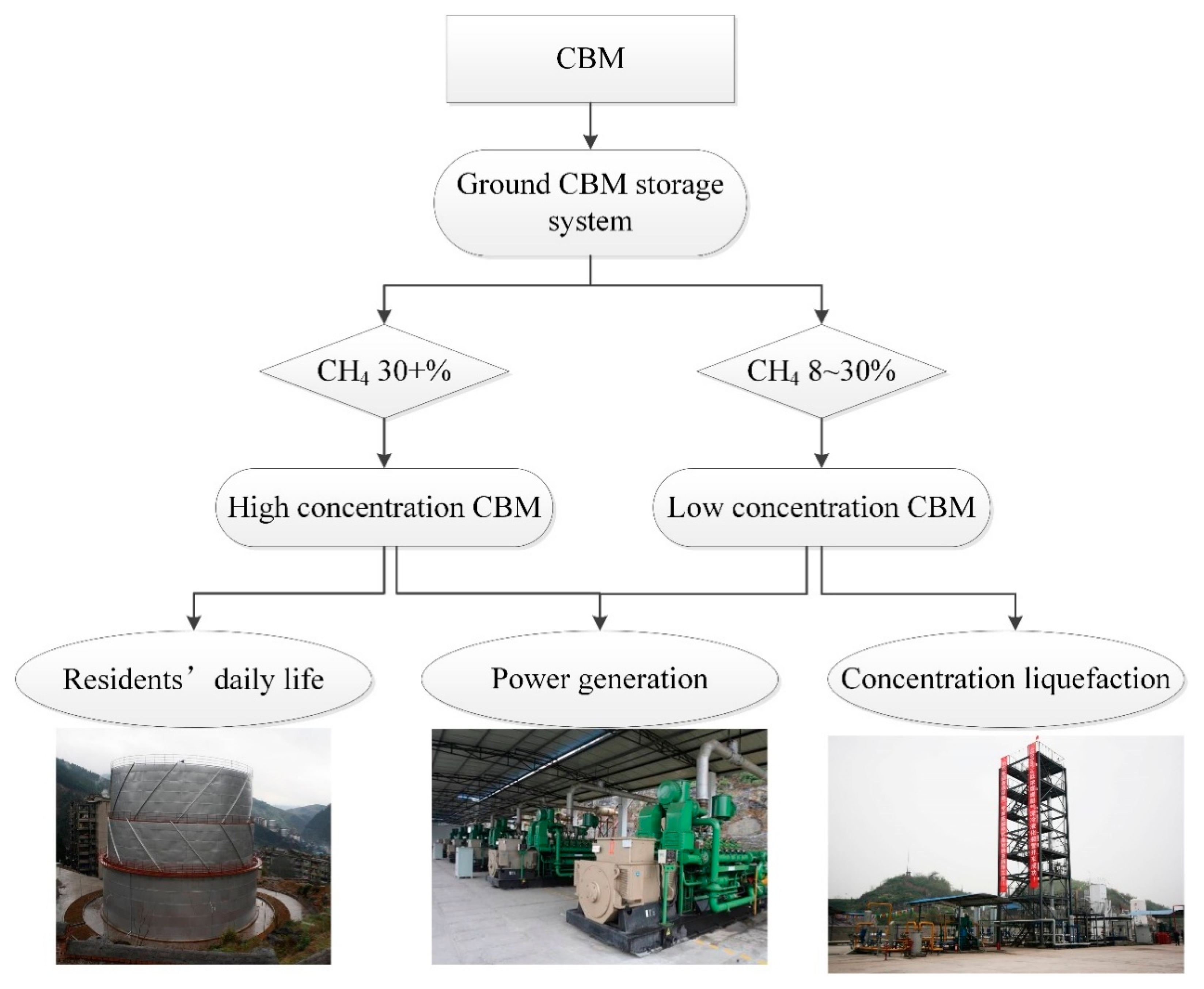
| Coal Seams | Seam Thickness /m | Firmness Coefficient | Gas Content /m3/t | Gas Pressure /MPa |
|---|---|---|---|---|
| M6 | 0.75~1.3 | 0.3~1.2 | 12.93~18.96 | 1.4~3.7 |
| 1.15 | 14.58 | 1.8 | ||
| M7 | 1.07~2.8 | 0.3~1.0 | 14.94~19.30 | 1.5~4.8 |
| 1.45 | 16.89 | 2.1 | ||
| M8 | 2.10~4.97 | 0.1~0.8 | 16.35~29.17 | 1.5~6.5 |
| 2.90 | 19.70 | 2.8 |
| Project | The Minimum Distance in Advance (m) |
|---|---|
| Pre-tunneling gas extraction before coal roadway tunneling in protective seam | 600 |
| Pre-mining gas extraction before coal mining in protective seam | 600 |
| Pre-tunneling gas extraction before coal roadway tunneling in protected outburst coal seam | 1000 |
| Pre-mining gas extraction before coal mining in protected seam | completed |
| Net-like pattern of cross-measure boreholes for gas pre extraction in protected seam when the protective seam start to mine | 300 |
© 2018 by the authors. Licensee MDPI, Basel, Switzerland. This article is an open access article distributed under the terms and conditions of the Creative Commons Attribution (CC BY) license (http://creativecommons.org/licenses/by/4.0/).
Share and Cite
Cheng, L.; Ge, Z.; Chen, J.; Ding, H.; Zou, L.; Li, K. A Sequential Approach for Integrated Coal and Gas Mining of Closely-Spaced Outburst Coal Seams: Results from a Case Study Including Mine Safety Improvements and Greenhouse Gas Reductions. Energies 2018, 11, 3023. https://doi.org/10.3390/en11113023
Cheng L, Ge Z, Chen J, Ding H, Zou L, Li K. A Sequential Approach for Integrated Coal and Gas Mining of Closely-Spaced Outburst Coal Seams: Results from a Case Study Including Mine Safety Improvements and Greenhouse Gas Reductions. Energies. 2018; 11(11):3023. https://doi.org/10.3390/en11113023
Chicago/Turabian StyleCheng, Liang, Zhaolong Ge, Jiufu Chen, Hao Ding, Lishuang Zou, and Ke Li. 2018. "A Sequential Approach for Integrated Coal and Gas Mining of Closely-Spaced Outburst Coal Seams: Results from a Case Study Including Mine Safety Improvements and Greenhouse Gas Reductions" Energies 11, no. 11: 3023. https://doi.org/10.3390/en11113023





